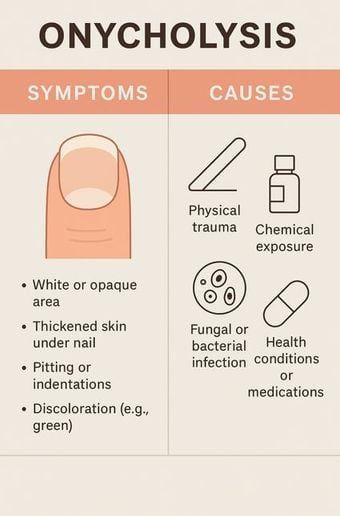Onycholysis is the separation of the nail plate from the nail bed. While it may look painful, it typically isn’t—at least not at first. But without proper care, this common nail disorder can lead to infections, deformities, and long-term damage.
In onycholysis, the nail acts like a lever, slowly pulling away from the nail bed. It can be caused by a wide range of factors, including:
- Physical trauma
- Chemical exposure
- Underlying skin conditions or systemic diseases
- Certain medications
While this condition often resolves on its own, it can take several months—sometimes up to a year for toenails—to fully recover, depending on severity and cause.
Common Symptoms of Onycholysis
Look for these visual and physical cues:
- White or opaque area on the nail where detachment occurs
- Thickened skin under the lifted nail
- Pitting or indentations on the nail surface
- Discoloration, especially if an infection sets in (green for bacterial, white for yeast)
- No initial pain, though discomfort may develop if infection or trauma continues

A chart that outlines the symptoms and causes of nail separation or onycholysis
Note: A separated nail opens the door for infections. “An area has opened that’s normally been clean and closed,” says Doug Schoon, an internationally-recognized scientist, author and educator with over 30 years experience in the cosmetic, beauty and personal care industry.
What Causes Onycholysis?
While multiple causes exist, physical trauma is the most common culprit. Other causes include:
Physical Trauma:
- Overfiling the natural nail
- Vigorous cuticle pushing or cleaning under the nail
- Tapping/typing, especially with long nails
- Wearing tight shoes (common with toenails)
- Blunt force (e.g., slamming a finger in a door)
Chemical and Product Irritants:
- Nail hardeners or adhesives
- Frequent wet work or prolonged water exposure
- Allergic contact dermatitis from nail products
Health-Related Causes:
- Psoriasis or thyroid disease
- Fungal or bacterial infections
- Medications that affect nail growth
Older clients may be more susceptible due to thinning skin and weaker nail bonds.

Example of nail separation or onycholysis in client.
Treatment and Recovery
Key Guidelines:
- Avoid trauma to the affected nail(s)
- Keep the area clean and dry
- Trim nails short and avoid manipulating the lifted area
- Do not attempt to remove the detached portion—this should be handled medically
- Refer to a doctor for diagnosis and treatment
If infection is suspected:
- A physician may order lab tests to confirm fungal involvement
- Medications or antifungals may be prescribed
Tips for Nail Technicians
If you see signs of onycholysis on a client:
Do:
- Recommend a physician visit for diagnosis
- Be gentle with the affected nails
- Shorten nail enhancements (without removing them)
- Keep nail beds dry during services
- Adjust services for lifestyle (e.g., suggest shorter nails for frequent typists)
Don’t:
- File aggressively or over-manipulate the nail
- Apply nail polish, remover, or enhancement chemicals on the affected nail
- Attempt to trim or remove the detached nail
Red Flag: If multiple clients are showing signs of onycholysis, examine your filing technique and service protocol for potential contributors.
For reprint and licensing requests for this article, Click here.
Adblock test (Why?)
Powered by WPeMatico

